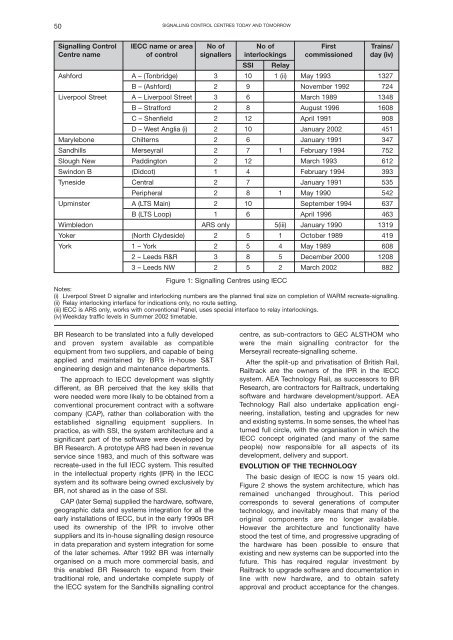Proceedings 2002/2003 - IRSE
Proceedings 2002/2003 - IRSE
Proceedings 2002/2003 - IRSE
You also want an ePaper? Increase the reach of your titles
YUMPU automatically turns print PDFs into web optimized ePapers that Google loves.
50<br />
SIGNALLING CONTROL CENTRES TODAY AND TOMORROW<br />
Signalling Control IECC name or area No of No of First Trains/<br />
Centre name of control signallers interlockings commissioned day (iv)<br />
SSI Relay<br />
Ashford A – (Tonbridge) 3 10 1 (ii) May 1993 1327<br />
B – (Ashford) 2 9 November 1992 724<br />
Liverpool Street A – Liverpool Street 3 6 March 1989 1348<br />
B – Stratford 2 8 August 1996 1608<br />
C – Shenfield 2 12 April 1991 908<br />
D – West Anglia (i) 2 10 January <strong>2002</strong> 451<br />
Marylebone Chilterns 2 6 January 1991 347<br />
Sandhills Merseyrail 2 7 1 February 1994 752<br />
Slough New Paddington 2 12 March 1993 612<br />
Swindon B (Didcot) 1 4 February 1994 393<br />
Tyneside Central 2 7 January 1991 535<br />
Peripheral 2 8 1 May 1990 542<br />
Upminster A (LTS Main) 2 10 September 1994 637<br />
B (LTS Loop) 1 6 April 1996 463<br />
Wimbledon ARS only 5(iii) January 1990 1319<br />
Yoker (North Clydeside) 2 5 1 October 1989 419<br />
York 1 – York 2 5 4 May 1989 608<br />
2 – Leeds R&R 3 8 5 December 2000 1208<br />
3 – Leeds NW 2 5 2 March <strong>2002</strong> 882<br />
Figure 1: Signalling Centres using IECC<br />
Notes:<br />
(i) Liverpool Street D signaller and interlocking numbers are the planned final size on completion of WARM recreate-signalling.<br />
(ii) Relay interlocking interface for indications only, no route setting.<br />
(iii) IECC is ARS only, works with conventional Panel, uses special interface to relay interlockings.<br />
(iv) Weekday traffic levels in Summer <strong>2002</strong> timetable.<br />
BR Research to be translated into a fully developed<br />
and proven system available as compatible<br />
equipment from two suppliers, and capable of being<br />
applied and maintained by BR’s in-house S&T<br />
engineering design and maintenance departments.<br />
The approach to IECC development was slightly<br />
different, as BR perceived that the key skills that<br />
were needed were more likely to be obtained from a<br />
conventional procurement contract with a software<br />
company (CAP), rather than collaboration with the<br />
established signalling equipment suppliers. In<br />
practice, as with SSI, the system architecture and a<br />
significant part of the software were developed by<br />
BR Research. A prototype ARS had been in revenue<br />
service since 1983, and much of this software was<br />
recreate-used in the full IECC system. This resulted<br />
in the intellectual property rights (IPR) in the IECC<br />
system and its software being owned exclusively by<br />
BR, not shared as in the case of SSI.<br />
CAP (later Sema) supplied the hardware, software,<br />
geographic data and systems integration for all the<br />
early installations of IECC, but in the early 1990s BR<br />
used its ownership of the IPR to involve other<br />
suppliers and its in-house signalling design resource<br />
in data preparation and system integration for some<br />
of the later schemes. After 1992 BR was internally<br />
organised on a much more commercial basis, and<br />
this enabled BR Research to expand from their<br />
traditional role, and undertake complete supply of<br />
the IECC system for the Sandhills signalling control<br />
centre, as sub-contractors to GEC ALSTHOM who<br />
were the main signalling contractor for the<br />
Merseyrail recreate-signalling scheme.<br />
After the split-up and privatisation of British Rail,<br />
Railtrack are the owners of the IPR in the IECC<br />
system. AEA Technology Rail, as successors to BR<br />
Research, are contractors for Railtrack, undertaking<br />
software and hardware development/support. AEA<br />
Technology Rail also undertake application engineering,<br />
installation, testing and upgrades for new<br />
and existing systems. In some senses, the wheel has<br />
turned full circle, with the organisation in which the<br />
IECC concept originated (and many of the same<br />
people) now responsible for all aspects of its<br />
development, delivery and support.<br />
EVOLUTION OF THE TECHNOLOGY<br />
The basic design of IECC is now 15 years old.<br />
Figure 2 shows the system architecture, which has<br />
remained unchanged throughout. This period<br />
corresponds to several generations of computer<br />
technology, and inevitably means that many of the<br />
original components are no longer available.<br />
However the architecture and functionality have<br />
stood the test of time, and progressive upgrading of<br />
the hardware has been possible to ensure that<br />
existing and new systems can be supported into the<br />
future. This has required regular investment by<br />
Railtrack to upgrade software and documentation in<br />
line with new hardware, and to obtain safety<br />
approval and product acceptance for the changes.

















